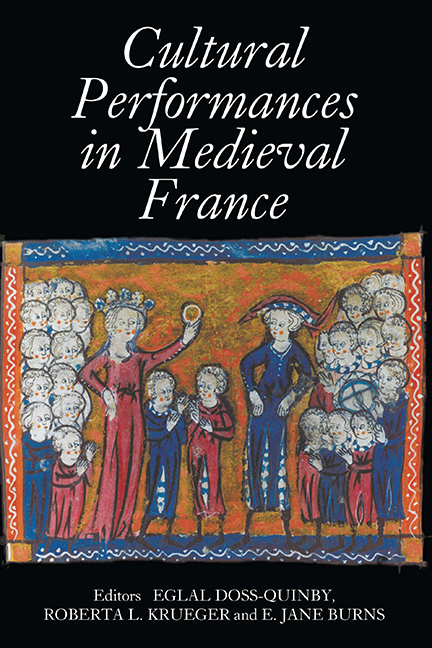Book contents
- Frontmatter
- Contents
- List of Illustrations
- Contributors
- Introduction
- Nancy Freeman Regalado, Curriculum Vitae
- PART I POETIC AND MUSICAL PERFORMANCES
- PART II PERFORMING SEXUAL AND SOCIAL IDENTITIES
- PART III DEVOTIONAL PRACTICE AND TEXTUAL PERFORMANCE
- PART IV PERSUASIVE PERFORMANCES
- PART V RE–ENACTMENTS AND LEGACIES
- Variegated Performance of Aucassin et Nicolette
- Late Medieval Representations of Storytelling and Story-Performance
- Paratextual Performances in the Early Parisian Book Trade: Antoine Vérard's Edition of Boccaccio's Nobles et cleres dames (1493)
- “Resuscitating” Medieval Literature in New York and Paris: La femme que Nostre-Dame garda d'estre arse at Yvette Guilbert's School of Theatre, 1919–24
- The Pitfalls and Promise of Classroom Performance
- ” Dunc chante haut et cler » : remarques sur l'interprétation de la musique médiévale
- Tabula Gratulatoria
- Tabula Gratulatoria
Variegated Performance of Aucassin et Nicolette
from PART V - RE–ENACTMENTS AND LEGACIES
Published online by Cambridge University Press: 24 October 2017
- Frontmatter
- Contents
- List of Illustrations
- Contributors
- Introduction
- Nancy Freeman Regalado, Curriculum Vitae
- PART I POETIC AND MUSICAL PERFORMANCES
- PART II PERFORMING SEXUAL AND SOCIAL IDENTITIES
- PART III DEVOTIONAL PRACTICE AND TEXTUAL PERFORMANCE
- PART IV PERSUASIVE PERFORMANCES
- PART V RE–ENACTMENTS AND LEGACIES
- Variegated Performance of Aucassin et Nicolette
- Late Medieval Representations of Storytelling and Story-Performance
- Paratextual Performances in the Early Parisian Book Trade: Antoine Vérard's Edition of Boccaccio's Nobles et cleres dames (1493)
- “Resuscitating” Medieval Literature in New York and Paris: La femme que Nostre-Dame garda d'estre arse at Yvette Guilbert's School of Theatre, 1919–24
- The Pitfalls and Promise of Classroom Performance
- ” Dunc chante haut et cler » : remarques sur l'interprétation de la musique médiévale
- Tabula Gratulatoria
- Tabula Gratulatoria
Summary
I happily dedicate this article to Nancy Freeman Regalado, a wonderful colleague. Her collaborative spirit and collegiality, her warm friendship, and her wise counsel have meant a great deal to me in my years at New York University.
The literary works that survive from the medieval period have come down to us in manuscripts. We are grateful for those manuscripts, as we are for the work of the scholars who edit and study them. But we also need to think beyond manuscripts, to the fact that few people in the Middle Ages actually read the words inscribed on those folios. It is through live performance of some kind that most men and women knew, experienced, and appreciated the works contained in manuscripts. In the Middle Ages, works were frequently recited from memory, sung, acted out, or read aloud; private reading was rare, silent reading practically non-existent.
My recent work focuses largely on issues relating to the performance of narrative. We all recognize that medieval plays were intended to be performed dramatically, and songs to be sung. But it is somehow harder for us today to conceive that most medieval narratives were also intended for live performance. (One problem is surely that storytelling in modern Western culture has been relegated to the world of children.) These pages are drawn from a book in progress that evaluates the “performability” of a number of French medieval narratives. My underlying argument is that works often contain within themselves a considerable amount of information as to how they were to be performed: they tell us whether they were to be recited, or acted out by one or more performers, or sung, or read aloud, or read privately; they may also tell us a good deal about the tone, mood, and performance style that are called for.
This article focuses on Aucassin et Nicolette. Many scholars have emphasized its considerable debt to the literature of the period – and indeed epic, historical discourse, romance, lyric, and saint's life are combined and woven together here in a delightful manner. This is a deeply literary work in the sense that what it sets before its audience is not “reality” but rather a mirror reflecting many different kinds of works of literature (or verbal eloquence).
- Type
- Chapter
- Information
- Cultural Performances in Medieval FranceEssays in Honor of Nancy Freeman Regalado, pp. 235 - 246Publisher: Boydell & BrewerPrint publication year: 2007

